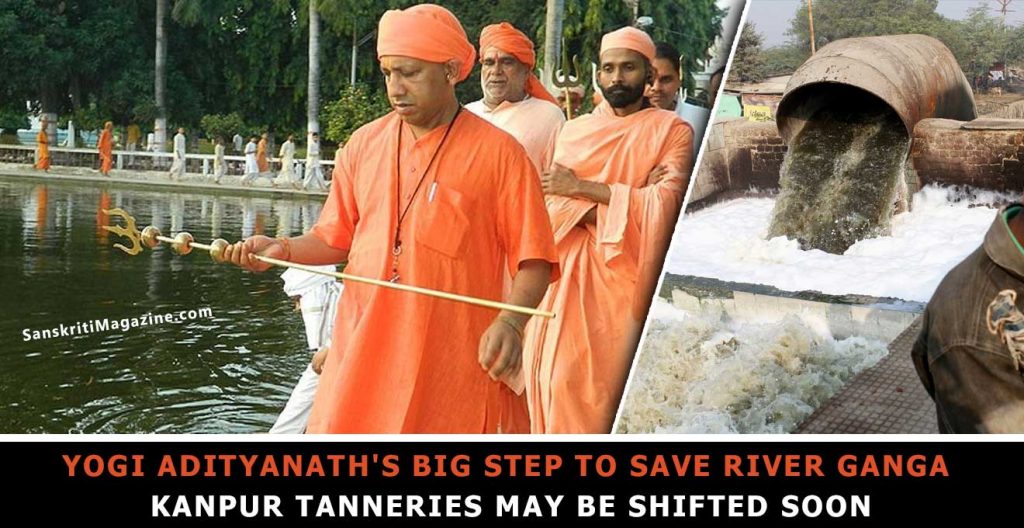New Delhi: UP CM Yogi Adityanath, known for taking big and bold steps, is likely to take another big decision to save river Ganga.
The Yogi Adityanath-led Uttar Pradesh government has favoured the shifting of British-era tanneries releasing toxic wastes into the river Ganga at Kanpur.
The UP government has told the National Green Tribunal that hunt for a new site for setting up of these leather units, which are the “major source of pollution” in Ganga, is under consideration and would be identified soon.
Last year, the then Akhilesh Yadav government had opposed the idea of shifting of over 400 tanneries giving employment to over two million people, saying the moving the tannery hubs to some other place was almost “next to impossible” due to paucity of land.
The Yogi government’s decision favouring shifting them was conveyed at a high-level meeting held in the NGT which was chaired by the green panel’s Chairman Justice Swatanter Kumar.
The NGT chief was apprised by the state’s Additional Chief Secretary of Environment & Forest that a call in principle has been taken to shift out the tanneries from the Jajmau cluster of Kanpur.
In the meeting, also attended by other stakeholders including officials from National Mission for Clean Ganga, the senior official told the green panel that the UP government has taken a policy decision that all the sources which pollute Ganga should be treated on the basis of definite data and information.
The decision got support from advocate M C Mehta who said that “the only viable option” was to shift the tanneries if we want to rejuvenate Ganga.
70-year-old Mehta, a Ramon Magsaysay awardee, had filed a PIL for cleaning of river Ganga before the Supreme Court in 1985. The apex court in 2014 transferred the case to NGT.
“There is no other alternative except shifting of these tanneries. Shifting of the leather units requires a strong will. The residents living near tanneries have to face the foul smell emanating from these units which is injurious to their health.
“Thousands of devotees visit Allahabad to take dip at Sangam but the water is not clean even there. The cleaning of Ganga which was undertaken earlier should be enquired into and the erring officials punished,” Mehta said.
However, environmentalist Himanshu Thakkar preferred not to rush to any conclusion and said that tanneries comprise only one aspect of many critically polluting industries identified by the Central Pollution Control Board (CPCB) and discharge from other industries like distilleries, sugar, paper and pulp units also need to be looked into.
“We will have to look into the UP government’s shifting proposal and what are the areas they have worked upon. If the tanneries are even shifted 100-150 km away even then it would be within the Ganga basin.
“So the state government needs to make proper arrangements before shifting these units and provide them with all facilities. Oherwise the condition will be the same,” Thakkar, river expert with the South Asia Network on Dams, Rivers and People, said.
The green panel, however, said the decision to shift tannery cluster rests entirely with the state government.
However, the existing industrial clusters at Jajmau and Unnao required establishment of an entirely new Common Effluent Treatment Plant with a separate chromium recovery plant and separate pipelines.
In a detailed report covering various aspects of contamination in the river, CPCB had informed the NGT that the Ganga, spanning a distance of 543 km between Haridwar and Kanpur, was affected by 1,072 seriously polluting industries which were releasing heavy metals and pesticides.
At present, 823.1 million litres per day (MLD) of untreated sewage and 212.42 MLD of industrial effluent flows into the river while three of the four monitored Sewage Treatment Plants were non-compliant with the set standards, it said.
The green panel has divided the work of cleaning the river in different segments Gomukh to Haridwar (Phase-I), Haridwar to Unnao (termed as segment B of Phase-I), Unnao to border of Uttar Pradesh, border of Uttar Pradesh to border of Jharkhand and border of Jharkhand to Bay of Bengal.











